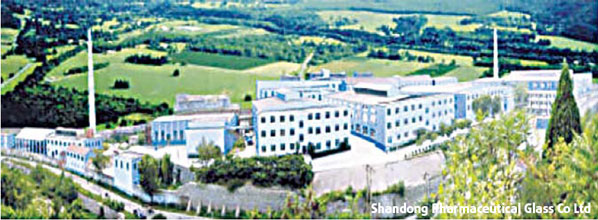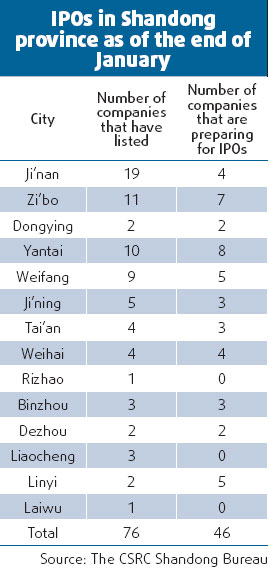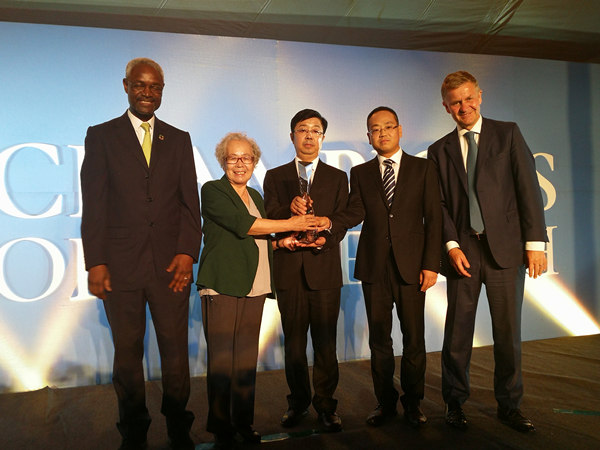


Following the lead of neighboring provinces Jiangsu and Zhejiang, East China's Shandong, which ranked seventh in 2007 in terms of GDP (gross domestic product) per capita, is pushing for IPO (initial public offering) initiatives within the region.
The local government is considering copying the success of central Shandong's Yiyuan county, which has gone from one of the province's poorest districts to an emerging economic engine by creating an IPO-friendly environment in recent years.
On March 10, about 270 high-level officials from roughly 30 major Shandong counties, drove to Yiyuan in Zibo city, a well-known revolutionary base in a mountainous area whose residents have been surviving by growing fruits and vegetables for the last five years.
Each official came with the same question in mind: How could an once poverty-stricken area rocket up to 10th place in terms of GDP among the province's 60 counties in only half a decade?
The secret is the IPO plan. During the 2002-07 period, the county successfully assisted four companies to debut at home and abroad, and now they are all leading their respective industries and have become regional economic pillars. In 2007, they were valued at 10 billion yuan in total, 10 times what they were worth before listing, and they contributed 25 percent of Yiyuan's tax income.
The visiting officials were all wondering if they could mimic the dazzling success story.
IPO-driven economy

The idea happened to coincide with the economic development blueprint designed recently by the Shandong government.
According to a statement from the Shandong development and reform commission issued on its website on March 17, the government will attempt to increase economic status mainly through promoting IPO projects. By 2010, at least 60 companies from the 30 counties will be listed, and five out of the 30 counties will have 10 companies listed.
Experts say strengthening the regional economy by boosting financial channels is a wise move. "The more companies that list, the more it boosts the local economy. Yiyuan provides the best example," says Sheng Xitai, president of Lianhe Securities.
But Yiyuan is not alone. By the end of 2007, in Jiangyin county, in central Jiangsu province, more than 20 companies had listed, and in Yangxunqiao town of Shaoxing county in Zhejiang province, there were eight.
What is also striking is their economic performance. In early 2004, Jiangyin surpassed Shunde in Guangdong province to become the richest county nationwide. Yangxunqiao also ranks first in Zhejiang for its economic status and is included in the list of China's top five towns.
Through the IPO strategy, government officials expect Shandong to catch up to its neighbors. Even though it is second place in terms of GDP, second to Guangdong province, Shandong is still lagging behind in terms of GDP per capita, following Beijing, Shanghai and Tianjin and Jiangsu, Zhejiang and Guangdong provinces.
This is partly attributed to its comparatively lower IPO ratio. As of December 12, a total of 152 Zhejiang companies had been listed at home and abroad. By 2006, 99 companies from Zhejiang had been listed in the domestic market, and in 2007, 26 companies issued public offerings overseas. But as of January, Shandong had only 76 IPOs, according to the China Securities Regulatory Commission (CSRC) Shandong Bureau.
And among the over 200 large- and mid-scale private companies in Shandong, only 20 of them were listed, and 95 percent of the provincial fundraising comes from banks and private financial institutions. The total value of shares listed in the domestic market owned by Shandong-based companies accounted for just 21 percent of the provincial GDP, far below the nationwide average, which stands at 50 percent.
Yiyuan phenomenon
There are reasons behind the IPO reluctance. As Shi Haoquan, standing deputy-mayor of Dezhou in Shandong, says, the companies "either know little about the rewards of an IPO, or are frightened by the costly and tediously long formalities before the IPO is launched, or lack the professional assistance to make it a success."
But why are companies from Yiyuan so enthusiastic? Officials from Yiyuan county believe the government should act as facilitators of IPO initiatives - and the government agrees.
"Yiyuan does not enjoy geographic or talent pool advantages. The regional economy could never make strides until there is an innovative development mode. And corporate capitalization is indeed an efficient alternative," says Han Guoxiang, secretary of the Yiyuan county Party committee.
The local Party committee and government set up an IPO-oriented working mechanism years ago, guiding and supporting qualified candidates in issuing IPOs. They promoted mergers and acquisitions to help build powerful industrial players, paving the way for IPOs. They exempted most of the fees the companies had to pay in the process of applying for IPOs. They launched a corporate development fund as a reward to companies who hold successful IPOs. And they learn from good examples to help those preparing for IPOs.
Their efforts help local companies gain confidence. In 2002, Shandong Pharmaceutical Glass Co Ltd (SPG) issued an IPO in Shanghai, and now it is Asia's largest pharmaceutical glass manufacturer.
The company's success fuelled the IPO wave. In 2005, Shandong Reyoung Pharmaceutical Co Ltd listed in Singapore.
Shandong Luyang Share Co Ltd, the largest manufacturer of refractory fibers in Asia, and Shandong Liaherd Chemical Industry Co Ltd, a leading chemicals producer in China, both debuted in 2008 in Shenzhen. Both domestic listings were designed and processed by the same IPO team employed by the SPG.
In 2007, Yiyuan generated a total output value of 11 billion yuan, 2.6 times that of 2002. In 2007, the four companies recorded revenues and profits worth 3.78 billion yuan and 1.1 billion yuan respectively, making up 27 percent and 48 percent of the county's total.
Initiatives on the go

For other Shandong counties, it is not enough to simply copy Yiyuan's success.
By 2007, there were only 26 IPO deals finalized in Shandong's 30 major counties, less than that of Jiangsu's Wuxi alone, which has the most IPOs.
Yin Fengting, director of the CSRC Shandong bureau, said in late 2007 that the organization will give top priority to pushing up IPO initiatives this year. And by 2011, the commission will partner with relevant institutions, providing IPO training courses to 1,000 selected companies, among which 200 qualified players will be specifically fostered, 150 could enter into application procedures and 100 could issue IPOs.
The commission's IPO drive started in early 2007 when it joined hands with Shenzhen Stock Exchange and set up the IPO cultivating center, through which a database covering updated statistics of 140 potential local companies was created. About 500 corporate representatives and government officials have gone through training courses.
The commission also appointed a team that visited 120 companies 180 times in Shandong's 60 counties last year, providing on-the-spot services and guidance.
Encouraged by the provincial government, 11 of the 17 cities in Shandong, including Yantai, Zibo, Dezhou and Rizhao, have launched IPO-related preferential policies and detailed five-year plans for IPO deals.
(China Daily 03/31/2008 page10)













